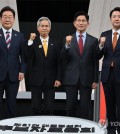- California Assembly OKs highest minimum wage in nation
- S. Korea unveils first graphic cigarette warnings
- US joins with South Korea, Japan in bid to deter North Korea
- LPGA golfer Chun In-gee finally back in action
- S. Korea won’t be top seed in final World Cup qualification round
- US men’s soccer misses 2nd straight Olympics
- US back on track in qualifying with 4-0 win over Guatemala
- High-intensity workout injuries spawn cottage industry
- CDC expands range of Zika mosquitoes into parts of Northeast
- Who knew? ‘The Walking Dead’ is helping families connect
South Korea Plans ‘Decapitation Unit’ to Try to Scare North’s Leaders
https://www.nytimes.com/2017/09/12/world/asia/north-south-korea-decapitation-.html

SEOUL, South Korea — The last time South Korea is known to have plotted to assassinate the North Korean leadership, nothing went as planned.
In the late 1960s, after North Korean commandoes tried to ransack the presidential palace in Seoul, South Korea secretly trained misfits plucked from prison or off the streets to sneak into North Korea and slit the throat of its leader, Kim Il-sung. When the mission was aborted, the men mutinied.
They killed their trainers and fought their way into Seoul before blowing themselves up, an episode the government concealed for decades.
Now, as Mr. Kim’s grandson, Kim Jong-un, accelerates his nuclear missile program, South Korea is again targeting the North’s leadership. A day after North Korea conducted its sixth — and by far most powerful — nuclear testthis month, the South Korean defense minister, Song Young-moo, told lawmakers in Seoul that a special forces brigade he described as a “decapitation unit” would be established by the end of the year.
The unit, officially known as the Spartan 3000, has not been assigned to literally decapitate North Korean leaders. But that is clearly the menacing message South Korea is trying to send.
ADVERTISEMENT
Mr. Song said the unit could conduct cross-border raids with retooled helicopters and transport planes that could penetrate North Korea at night.
Rarely does a government announce a strategy to assassinate a head of state, but South Korea wants to keep the North on edge and nervous about the consequences of further developing its nuclear arsenal. At the same time, the South’s increasingly aggressive posture is meant to help push North Korea into accepting President Moon Jae-in’s offer of talks.
It is a difficult balancing act, pitting Mr. Moon’s preference for a diplomatic solution against his nation’s need to answer an existential question: How can a country without nuclear weapons deter a dictator who has them?
“The best deterrence we can have, next to having our own nukes, is to make Kim Jong-un fear for his life,” said Shin Won-sik, a three-star general who was the South Korean military’s top operational strategist before he retired in 2015.
The measures have also raised questions about whether South Korea and the United States, the South’s most important ally, are laying the groundwork to kill or incapacitate Mr. Kim and his top aides before they can even order an attack.
While Secretary of State Rex W. Tillerson has said the United States doesnot seek leadership change in North Korea, and the South Koreans say the new military tactics are meant to offset the North Korean threat, the capabilities they are building could be used pre-emptively.

Last week, President Trump agreed to lift payload limits under a decades-old treaty, allowing South Korea to build more powerful ballistic missiles. The United States helped South Korea build its first ballistic missiles in the 1970s, but in return, imposed restrictions to try to prevent a regional arms race.
“We can now build ballistic missiles that can slam through deep underground bunkers where Kim Jong-un would be hiding,” Mr. Shin said. “The idea is how we can instill the kind of fear a nuclear weapon would — but do so without a nuke. In the medieval system like North Korea, Kim Jong-un’s life is as valuable as hundreds of thousands of ordinary people whose lives would be threatened in a nuclear attack.”
Although a majority of South Koreans, especially conservative politicians and commentators, call for arming their country with nuclear weapons of its own, Mr. Moon has repeatedly vowed to rid the Korean Peninsula of such weapons. In June, Mr. Trump reiterated Washington’s nuclear-umbrella doctrine, promising to protect the South with “the full range of United States military capabilities, both conventional and nuclear.”
But after North Korea tested two intercontinental ballistic missiles in July, including one that appeared capable of hitting the United States mainland, South Koreans are not so sure the Americans would follow through.
“Would the Americans intervene in a war on the peninsula if their own Seattle were threatened with a North Korean nuclear ICBM?” said Park Hwee-rhak, a military analyst at Kookmin University in Seoul.
Mr. Moon has vowed to expand the defense budget to 2.9 percent of South Korea’s gross domestic product during his term, from 2.4 percent, or $35.4 billion, as of this year. For next year, his government has proposed a budget of $38.1 billion, nearly $12 billion of it for weapons to defend against North Korea.
In a Twitter post last Tuesday, Mr. Trump said, “I am allowing Japan & South Korea to buy a substantially increased amount of highly sophisticated military equipment from the United States.”
South Korea has now introduced three arms-buildup programs — Kill Chain; the Korea Air and Missile Defense program; and the Korea Massive Punishment and Retaliation initiative, which includes the decapitation unit.
Under the Kill Chain program, South Korea aims to detect impending missile attacks from North Korea and launch pre-emptive strikes.
North Korea keeps artillery and rocket tubes near the border, and is capable of delivering 5,200 rounds on Seoul in the first 10 minutes of war, military planners in South Korea say. The North also operates hundreds of missiles designed to hit South Korea and United States bases in Japan and beyond to deter American intervention should war break out.
The need to detect an impending strike has become more critical. North Korea has made its nuclear bombs small and light enough — weighing under 500 kilograms, or about 1,100 pounds — to be fitted onto its missiles, though it is still unclear whether they are fully weaponized, Mr. Song, the defense minister, said last week.
But detection has also become harder.
North Korea hides missiles in its many underground tunnels. Switching to solid fuel has made some of its missiles easier to transport and faster to launch. In recent years, North Korea also has flight-tested missiles from submarines, which are tougher to detect.

And the potential consequences of accurate detection are huge. Miscalculation could prompt an unwarranted pre-emptive strike, which could start a regional nuclear war.
Speaking to a United States congressional hearing in June, the chairman of the Joint Chiefs of Staff, Gen. Joseph F. Dunford Jr., said, “We will see casualties, unlike anything we’ve seen in 60 or 70 years.”
Intelligence, surveillance and reconnaissance capabilities are crucial, said Daniel A. Pinkston, a defense expert at the Seoul campus of Troy University. Without those capabilities, “they would be ‘shooting blind’ because the missile units could not identify the targets,” he added.
Last month, South Korea said it would launch five spy satellites into orbit from 2021 to 2023 to better monitor weapons movements in North Korea. In the interim, it is talking with countries like France and Israel to lease spy satellites. It also plans to introduce four American RQ-4 Global Hawk surveillance drones by next year.
If pre-emptive attacks failed, South Korea would hope its Korea Air and Missile Defense would shoot down any rockets from the North.
South Korea is planning to upgrade its PAC-2 interceptor missiles for a better low-altitude defense. Last week, South Korea helped the United States military install a Thaad missile-defense battery, which intercepts enemy rockets at higher altitudes. For additional protection, South Korea is developing its own L-SAM interceptor missiles, as well as installing more early warning radars for ballistic missiles.
After the North’s latest nuclear test, South Korea fired its Hyunmoo-2 short-range ballistic missiles in a drill simulating an attack on the North’s test site. In July, the South’s military also released simulated images of Taurus bunker-buster missiles hitting the Defense Ministry in the North Korean capital, Pyongyang. South Korea is buying 260 Taurus missiles from a German and Swedish joint venture.
The weapons are part of the Korea Massive Punishment and Retaliation plan. Under that program, South Korea would try to divide Pyongyang into several districts and wipe out the area where Kim Jong-un is believed to be hiding, defense analysts said.
Washington’s decision to lift the missile payload limits may allow South Korea to develop new Hyunmoo missiles capable of destroying weapons sites and leadership bunkers deep underground, said Shin Jong-woo at Korea Defense Forum, a Seoul-based network of military experts.
Mr. Shin said there was talk of building a Hyunmoo with a two-ton warhead.
The earlier restrictions barred South Korea from attaching a payload weighing more than half a ton to its Hyunmoo missile when the rocket had a range of up to 497 miles.
As word of South Korea’s new assassination plans has spread, Mr. Kim has used his deputies’ cars as decoys to move from place to place, South Korean intelligence officials told lawmakers in June.
Still, many say they doubt that the threat is enough to deter Mr. Kim. Only the prospect of nuclear retaliation will suffice, they say.
“The balance of terror is the shortest cut to deterring war,” Yoon Sang-hyun, a conservative opposition lawmaker, told South Korea’s Parliament last Tuesday.











![방탄소년단(BTS) 제이홉 미국 빌보드 매거진 커버 [빌보드 제공. 재판매 및 DB 금지]](http://www.koreatimesus.com/wp-content/uploads/2025/05/1111-199x223.jpg)





fifa world cup 2018 live streaming
September 13, 2017 at 11:23 PM
The Republic of Ireland’s hopes of qualifying for the 2018 World Cup were severely dented after falling to a 1-0 home defeat to Serbia, while Turkey’s win over.
fifa u17 live
September 25, 2017 at 12:21 PM
Awesome
New Year 2018 Wishes
December 1, 2017 at 12:21 AM
Good work………….